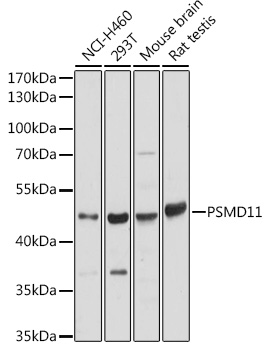Cell Biology Antibodies 5
Anti-PSMD11 Antibody (CAB15306)
- SKU:
- CAB15306
- Product Type:
- Antibody
- Reactivity:
- Human
- Reactivity:
- Mouse
- Reactivity:
- Rat
- Host Species:
- Rabbit
- Isotype:
- IgG
- Antibody Type:
- Polyclonal Antibody
- Research Area:
- Cell Biology
Description
| Antibody Name: | Anti-PSMD11 Antibody |
| Antibody SKU: | CAB15306 |
| Antibody Size: | 20uL, 50uL, 100uL |
| Application: | WB IHC IF |
| Reactivity: | Human, Mouse, Rat |
| Host Species: | Rabbit |
| Immunogen: | Recombinant fusion protein containing a sequence corresponding to amino acids 253-422 of human PSMD11 (NP_002806.2). |
| Application: | WB IHC IF |
| Recommended Dilution: | WB 1:200 - 1:2000 IHC 1:50 - 1:200 IF 1:50 - 1:200 |
| Reactivity: | Human, Mouse, Rat |
| Positive Samples: | NCI-H460, 293T, Mouse brain, Rat testis |
| Immunogen: | Recombinant fusion protein containing a sequence corresponding to amino acids 253-422 of human PSMD11 (NP_002806.2). |
| Purification Method: | Affinity purification |
| Storage Buffer: | Store at -20'C. Avoid freeze / thaw cycles. Buffer: PBS with 0.02% sodium azide, 50% glycerol, pH7.3. |
| Isotype: | IgG |
| Sequence: | YMLL CKIM LNTP EDVQ ALVS GKLA LRYA GRQT EALK CVAQ ASKN RSLA DFEK ALTD YRAE LRDD PIIS THLA KLYD NLLE QNLI RVIE PFSR VQIE HISS LIKL SKAD VERK LSQM ILDK KFHG ILDQ GEGV LIIF DEPP VDKT YEAA LETI QNMS KVVD SLYN KAKK LT |
| Gene ID: | 5717 |
| Uniprot: | O00231 |
| Cellular Location: | Cytoplasm, Nucleus, cytosol |
| Calculated MW: | 47kDa |
| Observed MW: | 47KDa |
| Synonyms: | PSMD11, Rpn6, S9, p44.5 |
| Background: | The 26S proteasome is a multicatalytic proteinase complex with a highly ordered structure composed of 2 complexes, a 20S core and a 19S regulator. The 20S core is composed of 4 rings of 28 non-identical subunits; 2 rings are composed of 7 alpha subunits and 2 rings are composed of 7 beta subunits. The 19S regulator is composed of a base, which contains 6 ATPase subunits and 2 non-ATPase subunits, and a lid, which contains up to 10 non-ATPase subunits. Proteasomes are distributed throughout eukaryotic cells at a high concentration and cleave peptides in an ATP/ubiquitin-dependent process in a non-lysosomal pathway. This gene encodes a member of the proteasome subunit S9 family that functions as a non-ATPase subunit of the 19S regulator and is phosphorylated by AMP-activated protein kinase. Alternatively spliced transcript variants have been observed for this gene. |
| UniProt Protein Function: | PSMD11: Component of the lid subcomplex of the 26S proteasome, a multiprotein complex involved in the ATP-dependent degradation of ubiquitinated proteins. In the complex, PSMD11 is required for proteasome assembly. Plays a key role in increased proteasome activity in embryonic stem cells (ESCs): its high expression in ESCs promotes enhanced assembly of the 26S proteasome, followed by higher proteasome activity. Belongs to the proteasome subunit S9 family. 2 isoforms of the human protein are produced by alternative splicing. |
| UniProt Protein Details: | Protein type:Protease; Proteasome complex Chromosomal Location of Human Ortholog: 17q11.2 Cellular Component: cytosol; membrane; nucleoplasm; nucleus; proteasome complex Molecular Function:protein binding Biological Process: anaphase-promoting complex-dependent proteasomal ubiquitin-dependent protein catabolic process; antigen processing and presentation of exogenous peptide antigen via MHC class I, TAP-dependent; MAPKKK cascade; negative regulation of ubiquitin-protein ligase activity during mitotic cell cycle; positive regulation of ubiquitin-protein ligase activity during mitotic cell cycle; proteasomal ubiquitin-dependent protein catabolic process; proteasome assembly; protein polyubiquitination; regulation of amino acid metabolic process; regulation of mRNA stability; stem cell differentiation; stimulatory C-type lectin receptor signaling pathway; T cell receptor signaling pathway; tumor necrosis factor-mediated signaling pathway; ubiquitin-dependent protein catabolic process; Wnt receptor signaling pathway, planar cell polarity pathway |
| NCBI Summary: | The 26S proteasome is a multicatalytic proteinase complex with a highly ordered structure composed of 2 complexes, a 20S core and a 19S regulator. The 20S core is composed of 4 rings of 28 non-identical subunits; 2 rings are composed of 7 alpha subunits and 2 rings are composed of 7 beta subunits. The 19S regulator is composed of a base, which contains 6 ATPase subunits and 2 non-ATPase subunits, and a lid, which contains up to 10 non-ATPase subunits. Proteasomes are distributed throughout eukaryotic cells at a high concentration and cleave peptides in an ATP/ubiquitin-dependent process in a non-lysosomal pathway. This gene encodes a member of the proteasome subunit S9 family that functions as a non-ATPase subunit of the 19S regulator and is phosphorylated by AMP-activated protein kinase. Alternatively spliced transcript variants have been observed for this gene. [provided by RefSeq, Jul 2012] |
| UniProt Code: | O00231 |
| NCBI GenInfo Identifier: | 20978543 |
| NCBI Gene ID: | 5717 |
| NCBI Accession: | O00231.3 |
| UniProt Secondary Accession: | O00231,O00495, Q53FT5, A8K3I7, E1P663, |
| UniProt Related Accession: | O00231 |
| Molecular Weight: | 47,535 Da |
| NCBI Full Name: | 26S proteasome non-ATPase regulatory subunit 11 |
| NCBI Synonym Full Names: | proteasome 26S subunit, non-ATPase 11 |
| NCBI Official Symbol: | PSMD11 |
| NCBI Official Synonym Symbols: | S9; Rpn6; p44.5 |
| NCBI Protein Information: | 26S proteasome non-ATPase regulatory subunit 11 |
| UniProt Protein Name: | 26S proteasome non-ATPase regulatory subunit 11 |
| UniProt Synonym Protein Names: | 26S proteasome regulatory subunit RPN6; 26S proteasome regulatory subunit S9; 26S proteasome regulatory subunit p44.5 |
| UniProt Gene Name: | PSMD11 |
| UniProt Entry Name: | PSD11_HUMAN |



![PSMD11 Monoclonal Antibody [PAT1F4AT] (CPAB0164) PSMD11 Monoclonal Antibody [PAT1F4AT] (CPAB0164)](https://cdn11.bigcommerce.com/s-rd6ounxcu2/images/stencil/590x590/products/58390/63572/psmd11-monoclonal-antibody-pat1f4at-cpab0164__04325__48150.1706534994.jpg?c=1)
![PSMD11 PAT2C7AT Monoclonal Antibody [PAT2C7AT] (CPAB0248) PSMD11 PAT2C7AT Monoclonal Antibody [PAT2C7AT] (CPAB0248)](https://cdn11.bigcommerce.com/s-rd6ounxcu2/images/stencil/590x590/products/58473/63655/psmd11-pat2c7at-monoclonal-antibody-pat2c7at-cpab0248__77210__55269.1706535024.jpg?c=1)


